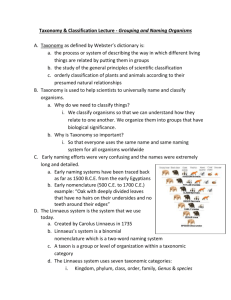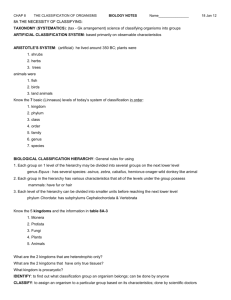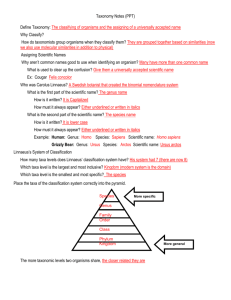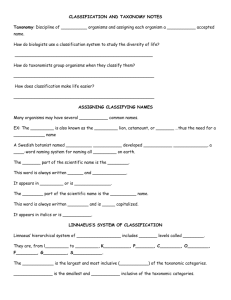CLASSIFICATION Chapter 18
advertisement
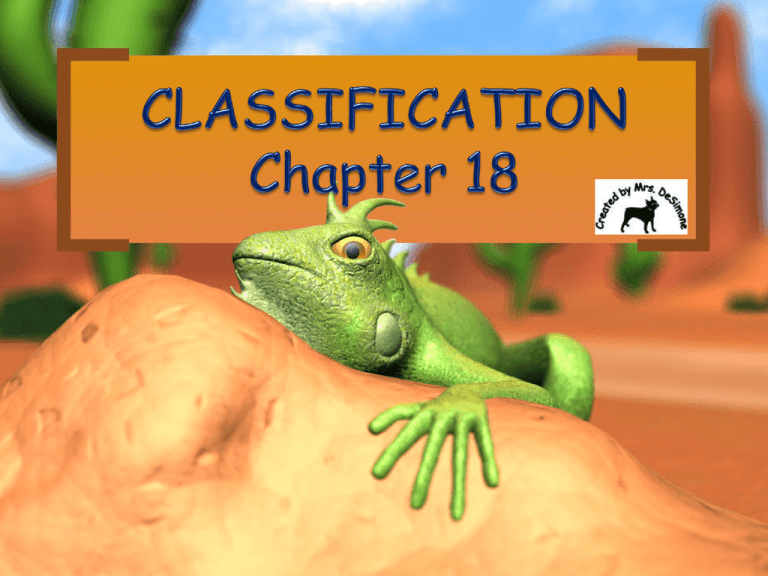
Reference Text: Modern Biology Chapter 18 – Section 1 Pgs. 336 - 341 • All Organisms on earth are said to have descended from an ancient common ancestor. WHAT THINGS DO WE CLASSIFY? WHY DO WE CLASSIFY THEM? Every Year, thousands of new species are discovered. To study so many life-forms, biologists organize or classify them into numerous groups based on similar characteristics (structures). Biological Classification: to group things according to similar/different structures that they share. Classification is very useful in Biology… • Indicates relationships between species • Accurately & uniformly names organisms; star fish and jelly fish aren't’ really fish TAXONOMY: The branch of biology that classifies organisms according to their characteristics and evolutionary history TAXONOMISTS: • scientists that identify & name organisms. • named organisms in a way that reflects their classification. • use the same language (Latin or some Greek) for all names. The first classification system was developed 2000 years ago by Greek Philosopher, Aristotle. He was the first taxonomist. • •He simply divided organisms into plants & animals •He then subdivided them by their habitat: •land, sea, or air dwellers •Plants, by stem structure As modern science developed and more & more organisms began to be discovered, Biologists realized Aristotle’s system was no longer adequate for naming & organizing all life on earth. Sea”horse”?? European bee: Apis pubescens, thorace subgriseo, abdomine fusco, pedibus posticis glabris utrinque margine ciliatis. Linnaeus’s System In response to the need for better organization, an 18th century Swedish botanist named Carolus Linnaeus offered a solution to the confusion of classifying and naming organisms. Carolus Linnaeus 1707 – 1778 • Created a hierarchical system for classifying • organisms Developed naming system still used today The “Father of Taxonomy” Linnaeus’s System Linnaeus classified organisms into nested Levels of Classification based on similarities in morphology (form & structure), rather than by location. For example, although Bats can fly, he classified them as mammals, not birds, because they share common traits with other mammals; they have hair, have live births and nurse their offspring with milk. Linnaeus’s System The Linnaeus System of Taxonomy uses a hierarchical system for classifying organisms from broadest to most specific. The Seven Levels of Classification! Kingdom Phylum Class Order Family Genus Species BROADEST TAXON Each category or level is called a taxa, hence the name taxonomy! MOST SPECIFIC Linnaeus’s System Levels of Classification! The Nested Nature of Biological Classification Levels of Classification Keep Plates Clean Or Family Gets Sick Taxonomic Classification Taxonomic Group: Kingdom: Phylum: Class: Order: Family: Genus: Species: Name: Genus & species tiger Animal Chordates Mammals Carnivores Felines Panthera tigris grey wolf Animal Chordates Mammals Carnivores Canines Canis lupus Which two animals would be more closely related, two from the same phylum or two from the same genus? Linnaeus’s System Linnaeus also developed the modern system of naming organisms known as: Binomial nomenclature Why? Common names can vary! What animal is this? mountain lion ______________ puma ______________ catamou ______________ cougar ______________ . . . are all names for the same animal Also, some early scientific names were often long and difficult to remember… The European bee, for example, carried the name Apis pubescens, thorace subgriseo, abdomine fusco, pedibus posticis glabris utrinque margine ciliatis. Binomial nomenclature is a two-part naming system that identifies a species with 2 names: Uses Genus & species Either Latin or Greek Italicized in print Capitalize Genus, but NOT species Underline when writing Turdus migratorius American Robin Binomial Nomenclature Which TWO are more closely related? copyright cmassengale 30
